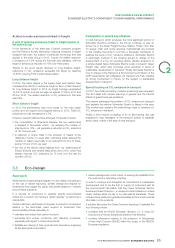APC 2012 Annual Report Download - page 69
Download and view the complete annual report
Please find page 69 of the 2012 APC annual report below. You can navigate through the pages in the report by either clicking on the pages listed below, or by using the keyword search tool below to find specific information within the annual report.
2012 REGISTRATION DOCUMENT SCHNEIDER ELECTRIC 67
SUSTAINABLE DEVELOPMENT
2
SCHNEIDER ELECTRIC’S COMMITMENT TO ENVIRONMENTAL PERFORMANCE
As an integral part of the eco-design approach, the PEP program
provides customers with the environmental impact of products
during their life cycle according to the ISO14040 standard. This
program applies to all offers developed by Schneider Electric.
This is an independent certifi cation by the association
PEPecopassport, based on ISO14025, and it provides an additional
level of rigor, reliability and transparency.
The EoLI program integrates the idea of recycling into the design
of products in order to promote recovery of end-of-life materials.
Schneider Electric has developed a design rules guide in order
to optimize end-of-life costs and the potential recycling rate of its
products.
These practices result in the publication of information and
recommendations to facilitate recycling of subsets or components
stated in the WEEE (Waste Electrical and Electronic Equipment)
European directive. Even though the vast majority of Schneider
Electric product offers do not fall under this directive, Schneider
Electric makes the End-Of-Life Instructions information sheets
available to its customers. This allows customers to identify and
locate the subsets or components so that they are able to recycle
them using suitable processes that are environmentally friendly.
Eco-Design Strategy
By focusing its efforts to improve the environmental footprint of its
offerings on the protection of people and the environment, climate
change and resource scarcity while addressing environmental issues
with its suppliers and its manufacturing processes and logistics,
in 2012 Schneider Electric consolidated its Eco-design strategy
in line with its Environment policy, its commitment to sustainable
development and the evolution of international directives and
standards.
Compliance with WEEE and equivalent legislation
A number of political commitments and regulations address
the issue of waste from electrical products. One example is the
European Waste Electrical and Electronic Equipment directive
(WEEE), which has been transposed into law in each Member
State. Similar regulations have been adopted or initiated in Japan,
China, India and the United States.
The WEEE directive’s main objective is to increase the recovery
rate for the largest types of electrical waste, such as televisions,
refrigerators and lighting systems, as well as for short-lived IT and
telecommunication equipment. Industrial electrical and electronic
devices and electrical distribution equipment are only very
marginally concerned as of now. Under the directive, the equipment
manufacturer is responsible for setting up and fi nancing dedicated
solutions to collect and process discarded equipment. The directive
sets minimum rates for recovery and recycling.
Schneider Electric is actively involved in a responsible approach
even though virtually none of its products are covered by the
directive.
As a responsible company, Schneider Electric must be able to
prove the existence of established end-of-life solutions. These must
be fi nanced and certifi ed for collecting, processing and recycling
end-of-life products in a way that respects both human health and
the environment.
Carried out in close cooperation with all Group partners, the
approach is deployed at the national level in each host country.
This involves identifying, certifying and in some cases organizing
solutions for processing waste from electrical equipment, with the
application of the appropriate indicators.
Green Plastic Program
This technological innovation program aims to make plastic parts
less hazardous to health and the environment in order to offer
products and solutions today in accordance with the principles of
sustainable development. In effect, plastic is present in almost all
Schneider Electric products and the amount of CO2 equivalents
needed to produce the plastic is estimated at 550,000tons per
year. The Green Plastic program is carried out in collaboration with
the businesses and the teams in charge of material purchasing
and design, and is part of the Group’s actions for sustainable
development.
The program follows a unique strategy for each type of plastic
focusing around three successive progress plans. A “green” plastic
must therefore:
1. be exempt from potentially toxic substances and have an end-of-
life evaluation scenario that respects the environment (material or
energy);
2. come from a production sector that has low CO2 use (recycled
plastic or plastic from renewable sources) and be capable of
limiting fossil fuel demand as well as energy and water;
3. come from a resource that does not compete with the food sector
either directly or indirectly, in the case that the Green Plastic
solution makes good use of a raw material from a renewable
source.
The added value that customers expect from “green” plastics lies
in two major areas:
•applications exempt from substances of very high concern,
particularly including non-PVC and non-halogen fl ame retardant
plastics product ranges;
•energy effi cient or electric vehicle offers that use plastics with a
very low environmental impact.
Schneider Electric uses a partnership approach in order to make
progress in research in this area. The Group therefore participates
in collaborative platforms such as the Paristech Mines Bioplastics
Chair or the Axelera competitive clusters initiative (in sustainable
chemistry) and Plastipolis (in plastics engineering).
By actively participating in the Polywood project, Schneider
Electric has solidifi ed its commitment to bio-plastics from non-food
resources. Under the acronym Polywood, this collaborative project
encompasses the development of a bio-refi nery fueled by wood
by-products provided by the paper industry.
























